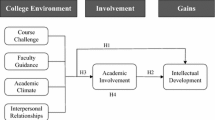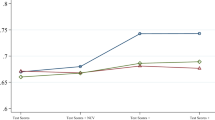Abstract
In recent years, the role of fraternities and sororities on college campuses has come under increasing scrutiny. Results of the National Study of Student Learning (NSSL) indicate that membership in a Greek organization can have a negative effect on students' cognitive development, particularly during the first year of college. The present research sought to assess the generalizability of the NSSL findings to first-year students attending a research university in the Midwest. In contrast to the NSSL findings, results indicated that Greek students had higher levels of involvement and gains in general abilities than did non-Greek students. Moreover, Greeks' gains in cognitive development were the result of their social involvement. Implications for the Greek system, as well as implications for the study of college effects, are discussed.
Similar content being viewed by others
REFERENCES
Alwin, D. F., & Jackson, D. J. (1980). Measurement models for response errors in surveys: Issues and applications. In K. F. Schuessler (Ed.). Sociological methodology 1980 (pp. 68–119). San Francisco: Jossey-Bass.
American College Testing Program. (1989). Report on the technical characteristics of CAAP: Pilot Year 1: 1988–89. Iowa City, IA: Author.
American College Testing Program. (1998). ACT Assessment examination. Iowa City, IA: Author.
Astin, A. W. (1970a). The methodology of research on college impact (I). Sociology of Education, 43, 223–254.
Astin, A. W. (1970b). The methodology of research on college impact (II). Sociology of Education, 43, 437–450.
Astin, A. W. (1977). Four critical years. San Francisco: Jossey-Bass.
Astin, A. W. (1993). What matters in college? Four critical years revisited. San Francisco: Jossey-Bass.
Baier, J. L., & Whipple, E. G. (1990). Greek values and attitudes: A comparison with independents. NASPA Journal, 28, 43–53.
Baird, L. L. (1969). The effects of college residence groups on students' self-concepts, goals, and achievements. Personnel and Guidance Journal, 47, 1015–1021.
Baird, L. L. (1988). Diverse and subtle arts: Assessing the generic outcomes of higher education. In C. Adelman (Ed.). Performance and judgement: Essays on principles and practice in the assessment of college student learning (pp. 39–62). Washington, DC: U.S. Government Printing Office.
Blimling, G. S. (1993). The influence of college residence halls on students. In J. C. Smart (Ed.). Higher education: Handbook of theory and research (Vol. IX, pp. 248–307). New York: Agathon.
Chickering, A. W. (1975). Commuting versus resident students. San Francisco: Jossey-Bass.
Clark, B. R. (1962). Educating the expert society. San Francisco: Chandler.
Cohen, J., & Cohen, P. (1983). Applied multiple regression/correlation analysis for the behavioral sciences (2nd ed.). Hillsdale, NJ: Lawrence Erlbaum.
Davis, T. M., & Murrell, P. H. (1993). A structural model of perceived academic, personal, and vocational gains related to college student responsibility. Research in Higher Education, 34, 267–290.
Feldman, K. A., & Newcomb, T. M. (1969). The impact of college on students. New Brunswick, NJ: Transaction.
Forrest, A., & Steele, J. M. (1982). Defining and measuring general education knowledge and skills. Iowa City, IA: ACT National Center for the Advancement of Educational Practice.
Hu, L., & Bentler, P. M. (1998). Fit indices in covariance structure modeling: Sensitivity to underparameterized model misspecification. Psychological Methods, 3, 424–453.
Hu, L., & Bentler, P. M. (1999). Cutoff criteria for fit indexes in covariance structure analysis: Conventional criteria versus new alternatives. Structural Equation Modeling, 6, 1–55.
Jakobsen, L. (1986). Greek affiliation and attitude change: Developmental implications. Journal of College Student Personnel, 27, 523–527.
Jöreskog, K. G., & Sörbom, D. (1999). LISREL 8.30: User's reference guide. Chicago: Scientific Software.
Kuh, G. D., & Lyons, J. W. (1990). Fraternities and sororities: Lessons from the College Experiences Study. NASPA Journal, 28, 20–29.
Kuh, G. D., Pascarella, E. T., & Wechsler, H. (1996). The questionable value of fraternities. Chronicle of Higher Education, 42(32), A68.
Kuh, G. D., Vesper, N., Connolly, M. R., & Pace, C. R. (1997). College Student Experiences Questionnaire: Revised norms for the 3rd edition, 1997. Bloomington: Indiana University Center for Postsecondary Research and Planning.
Loehlin, J. C. (1992). Latent variable models: An introduction to factor, path, and structural analysis (2nd ed.). Hillsdale, NJ: Lawrence Erlbaum.
Maisel, J. M. (1990). Social fraternities and sororities are not conducive to the educational process. NASPA Journal, 28, 8–12.
Marsh, H. W. (1994). Confirmatory factor analysis models of factorial invariance: A multifaceted approach. Structural Equation Modeling, 1, 5–34.
Marsh, H. W., Balla, J. R., & McDonald, R. P. (1988). Goodness-of-fit indices in confirmatory factor analysis: The effect of sample size. Psychological Bulletin, 103, 391–410.
Mulaik, S. A., James, L. R., Van Alstine, J., Benett, N., Lind, S., & Stidwell, C. D. (1989). Evaluation of goodness-of-fit indices for structural equation models. Psychological Bulletin, 105, 430–445.
Osterlind, S. J. (1989). College BASE: Guide to test content. Chicago: Riverside.
Pace, C. R. (1990). College Student Experiences Questionnaire (3rd ed., 1990). Bloomington: Indiana University Center for Postsecondary Research and Planning.
Pascarella, E. T., Whitt, E. J., Nora, A., Edison, M., Hagedorn, L. S., & Terenzini, P. T. (1996). What have we learned from the first year of the National Study of Student Learning? Journal of College Student Development, 37, 182–192.
Pascarella, E. T., Edison, M., Whitt, E. J., Nora, A., Hagedorn, L. S., & Terenzini, P. T. (1996). Cognitive effects of Greek affiliation during the first year of college. NASPA Journal, 33, 242–259.
Pascarella, E. T., & Terenzini, P. T. (1991). How college affects students: Findings and insights from 20 years of research. San Francisco: Jossey-Bass.
Penn, J. R. (1974). College student life style and frequency of alcohol usage. Journal of the American College Health Association, 22, 220–222.
Pike, G. R. (1995). The relationship between self reports of college experiences and achievement test scores. Research in Higher Education, 36, 1–21.
Pike, G. R. (1996). Limitations of using students' self-reports of academic development as proxies for achievement-test scores. Research in Higher Education, 37, 89–114.
Pike, G. R. (1999). The effects of residential learning communities and traditional residential living arrangements on educational gains during the first year of college. Journal of College Student Development, 40, 269–284.
Pike, G. R., & Askew, J. W. (1990). The impact of fraternity or sorority membership on academic involvement and learning outcomes. NASPA Journal, 28, 13–19.
Strange, C. (1986). Greek affiliation and goals of the academy: A commentary. Journal of College Student Personnel, 27, 519–523.
Student Life Studies. (1997, Winter). The influence of Greek affiliation on students' college experiences and educational outcomes. Student Life Studies Abstracts (No. 3). Columbia: University of Missouri–Columbia Office of Student Life Studies.
Thorson, E. (1997). Greek and non-Greek college and university alumni: Giving, community participation, and retrospective college satisfaction. Columbia: University of Missouri–Columbia Center for Advanced Social Research.
Tucker, L. R., & Lewis, C. (1973). A reliability coefficient for maximum likelihood factor analysis. Psychometrika, 38, 1–10.
Wechsler, H., Kuh, G. D., & Davenport, A. E. (1996). Fraternities, sororities, and binge drinking: Results from a national study of American colleges. NASPA Journal, 33, 260–279.
Whitt, E. J., Edison, M., Pascarella, E. T., Nora, A., & Terenzini, P. T. (1999). Interaction with peers and objective and self-reported cognitive outcomes across 3 years of college. Journal of College Student Development, 40, 61–78.
Wilder, D. H., Hoyt, A. E., Doren, D. M., Hauck, W. E., & Zettle, R. D. (1978). The impact of fraternity or sorority membership on values and attitudes. Journal of College Student Personnel, 19, 445–449.
Wilder, D. H., Hoyt, A. E., Surbeck, B. S., Wilder, J. C., & Carney, P. I. (1986). Greek affiliation and attitude change in college students. Journal of College Student Personnel, 27, 510–519.
Winston, R. B., & Saunders, S. A. (1987). The Greek experience: Friend or foe of student development? In R. B. Winston, W. R. Nettles III, & J. R. Opper, Jr. (Eds.). Fraternities and sororities on the contemporary college campus (New Directions for Student Services Series, no. 40, pp. 5–20). San Francisco: Jossey-Bass.
Wolfle, L. M. (1985). Applications of causal models in higher education. In J. C. Smart (Ed.). Higher education: Handbook of theory and research (Vol. I, pp. 381–414). New York: Agathon.
Author information
Authors and Affiliations
Rights and permissions
About this article
Cite this article
Pike, G.R. The Influence of Fraternity or Sorority Membership on Students' College Experiences and Cognitive Development. Research in Higher Education 41, 117–139 (2000). https://doi.org/10.1023/A:1007046513949
Issue Date:
DOI: https://doi.org/10.1023/A:1007046513949




